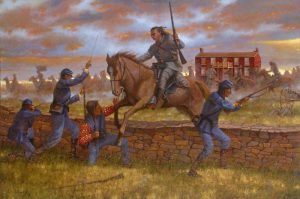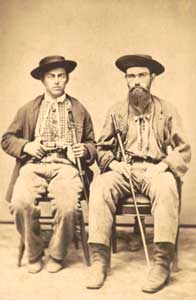
Guerilla Warfare in the Civil War
Battles:
Kirksville – August 6-9, 1862
Independence – August 11, 1862
Compton’s Ferry – August 10-August 13, 1862
Yellow Creek – August 13, 1862
Lone Jack – August 15-16, 1862
Newtonia – September 30, 1862
Clark’s Mill – November 7, 1862
The struggle in the Trans-Mississippi Theater was an integral and often significant part of the larger conflict of the Civil War. Though these operations were usually smaller than those in other theaters, they shaped the course of events on both sides of the Mississippi River.
At the beginning of 1862, the Union was in a precarious position in Missouri. Confederate General Sterling Price’s Missouri State Guard controlled the state’s interior, including large sections of the strategically important Missouri River Valley, and Confederate guerrillas ran rampant through the state.
It was up to the newly-installed commander of the Department of the Missouri, Major General Henry W. Halleck, to come up with a plan for the upcoming campaign season and remove the Confederate forces from Missouri.
Halleck soon instructed Brigadier General Samuel R. Curtis, commander of the recently-formed Federal Army of the Southwest, to implement his plans, and several battles took place.
Kirksville – August 6-9, 1862 – Part of the Operations North of Boston Mountains Campaign, this battle took place in Adair County on August 6-9, 1862. Colonel John McNeil and his troops, numbering about 1,000, pursued Colonel Joseph C. Porter and his Confederate Missouri Brigade of 2,500 men for over a week. Before noon on August 6, McNeil attacked Porter in Kirksville, where his men had hidden in homes and stores and among the crops in the nearby fields. After almost three hours of fighting, the Yankees secured the town, captured numerous prisoners, and chased the others away. Three days later, another Union force met and finished the work begun at Kirksville, destroying Porter’s command. Kirksville helped consolidate Union dominance in northeastern Missouri. The Union victory resulted in estimated casualties of 88 Union and 368 Confederate.
First Battle of Independence – August 11, 1862 – Taking place in Jackson County on August 11, 1862, this battle was part of the Operations North of Boston Mountains Campaign. On August 11, 1862, Colonel J.T. Hughes’ Confederate forces, including William Quantrill, attacked Independence, at dawn, in two columns on different roads. They drove through the town to the Union Army camp, capturing, killing, and scattering the Yankees. Lieutenant Colonel James T. Buel, the garrison commander, attempted to hold out in one of the buildings with some of his men. Soon the building next to them was on fire, threatening them. Using a flag of truce, Buel then arranged a meeting with the Confederate commander, Colonel G.W. Thompson, who had replaced Colonel J.T. Hughes, killed earlier. Buel surrendered, and about 150 of his men were paroled; the others had escaped, hidden, or been killed. Having taken Independence, the Rebel force headed for Kansas City. Confederate dominance in the Kansas City area continued, but not for long. The Confederate victory resulted in approximately 344 Union casualties, but the number of Confederates is unknown.
Compton’s Ferry – August 10-August 13, 1862 – This battle occurred in Livingston County, Missouri, from August 10 to August 13, 1862, when Confederate Colonel John A. Poindexter and 1200-1500 Confederate men were caught at Compton Ferry along the Grand River. Union Colonel Odon Guitar and his 550 men pursued Poindexter and his troops for 250 miles and attacked the guerrilla forces three times. They were confronted at Switzler’s Mill, Compton’s Ferry, and on the Muscle Fork of the Chariton River. Here the Federals caught the rebels in the act of crossing the river, causing great havoc and sending them into a headlong retreat. 150 Confederate soldiers were wounded, killed, or drowned during the battle, and another 100 soldiers were taken as prisoners. The Union was also able to obtain large amounts of ammunition and supplies. The Union suffered only five men wounded and ten horses killed. Afterward, Colonel Guitar joined Brigadier General Benjamin Loan and his men and continued pursuing Poindexter and his troops, soon dealing them a devastating blow at the Battle of Yellow Creek.
Yellow Creek – August 13, 1862 – After the Battle of Compton’s Ferry, Confederate Colonel John A. Poindexter and his force retreated along Yellow Creek in Chariton County, Missouri. They were pursued by Union forces, including the 9th Missouri State Militia Cavalry and the 2nd Missouri Volunteer Cavalry under Union Colonel Odon Guitar and Brigadier General Benjamin F. Loan. They intercepted the Confederates at Yellow Creek. Poindexter’s force was routed and effectively ceased to exist. Poindexter was wounded in action but escaped. He was later captured on September 1, 1863, wearing civilian clothes. Afterward, Governor Gamble promoted Colonel Guitar to Brigadier-General of the Enrolled Missouri Militia.
Lone Jack – August 15-16, 1862 – Part of the Operations North of Boston Mountains Campaign, this battle occurred in Jackson County on August 15-16, 1862. Major Emory S. Foster, under orders, led an 800-man combined force from Lexington to Lone Jack. Upon reaching the Lone Jack area, he discovered 1,600 Rebels under Colonel J.T. Coffee and prepared to attack them. At about 9:00 pm on the 15th, he and his men attacked the Confederate camp and dispersed the force. Early the following day, Union pickets informed Foster that a 3,000-man Confederate force was advancing on him. Soon afterward, this force attacked, and a battle ensued that involved charges, retreats, and counterattacks. After five hours of fighting and the loss of Foster, Coffee and his 1,500 men reappeared, causing Foster’s successor, Captain M.H. Brawner, to order a retreat. The men left the field in good order and returned to Lexington. This was a Confederate victory, but the Rebels had to evacuate the area soon afterward when threatened by the approach of large Union forces. Except for a short period during Price’s Raid, in 1864, the Confederacy lost its clout in Jackson County. The Confederate victory resulted in 160 Union casualties and 110 Confederate.
First Battle of Newtonia – September 30, 1862 – Part of the Operations North of Boston Mountains Campaign, this battle was fought in Newton County on September 30, 1862. Following the Battle of Pea Ridge, Arkansas, in March 1862, most Confederate and Union troops left northwestern Arkansas and southwestern Missouri. Confederates returned to the area by late summer, which caused much apprehension in nearby Federally-occupied Springfield, Missouri, and Fort Scott, Kansas. Confederate Colonel Douglas Cooper reached the area on September 27 and assigned two of his units to Newtonia, where there was a mill for making breadstuffs. Two brigades of Brigadier General James G. Blunt’s Union Army of Kansas left Fort Scott for Southwest Missouri in mid-September. On the 29th, Union scouts approached Newtonia but were chased away. Other Union troops appeared in nearby Granby, where there were lead mines, and Cooper sent some reinforcements there. The next morning, Union troops appeared before Newtonia, and fighting ensued by 7:00 am. The Federals began driving the enemy, but Confederate reinforcements arrived, swelling the numbers. The Federals gave way and retreated in haste. Some of their reinforcements appeared and helped stem their retreat as they did so. The Union forces then renewed the attack, threatening the enemy’s right flank. But newly arrived Confederates stopped that attack and eventually forced the Federals to retire again. The pursuit of the Federals continued after dark. Union gunners posted artillery in the roadway to halt the pursuit. As Confederate gunners observed the Union artillery fire for location, they fired back, creating panic. The Union retreat turned into a rout as some ran all the way to Sarcoxie, more than ten miles away. Although the Confederates won the battle, they could not maintain themselves in the area, given the great numbers of Union troops. Most Confederates retreated into northwest Arkansas. The 1862 Confederate victories in southwestern Missouri at Newtonia and Clark’s Mill were the South’s high point. Afterward, the only Confederates in the area belonged to raiding columns. The Confederate victory left 245 Union casualties and 100 Confederate.
Clark’s Mill – November 7, 1862 – Also called the Battle of Vera Cruz, this skirmish took place in Douglas County, Missouri, as part of the Operations North of Boston Mountains Campaign on November 7, 1862. Having received reports that Confederate troops were in the area, Captain Hiram E. Barstow, Union commander at Clark’s Mill, sent a detachment toward Gainesville, and he led another southeastward. Barstow’s men ran into a Confederate force, skirmished, and drove them back. His column then fell back to Clark’s Mill, where he learned that another Confederate force was coming from the northeast. Unlimbering artillery to command both approach roads, Barstow was soon engaged in a five-hour fight with the enemy. Under a white flag, the Confederates demanded a surrender, and the Union, given their numerical inferiority, accepted. The Confederates paroled the Union troops and departed after burning the blockhouse at Clark’s Mill. Clark’s Mill helped the Confederates to maintain a toehold in southwest Missouri. The Confederate victory resulted in 113 Union casualties; the Confederate casualties are unknown.
Compiled and edited by Kathy Alexander/Legends of America, updated June 2023.
Also See:
Civil War Timeline & Leading Events
Sources:
Civil War on the Western Border
National Park Service – Battle Summaries






